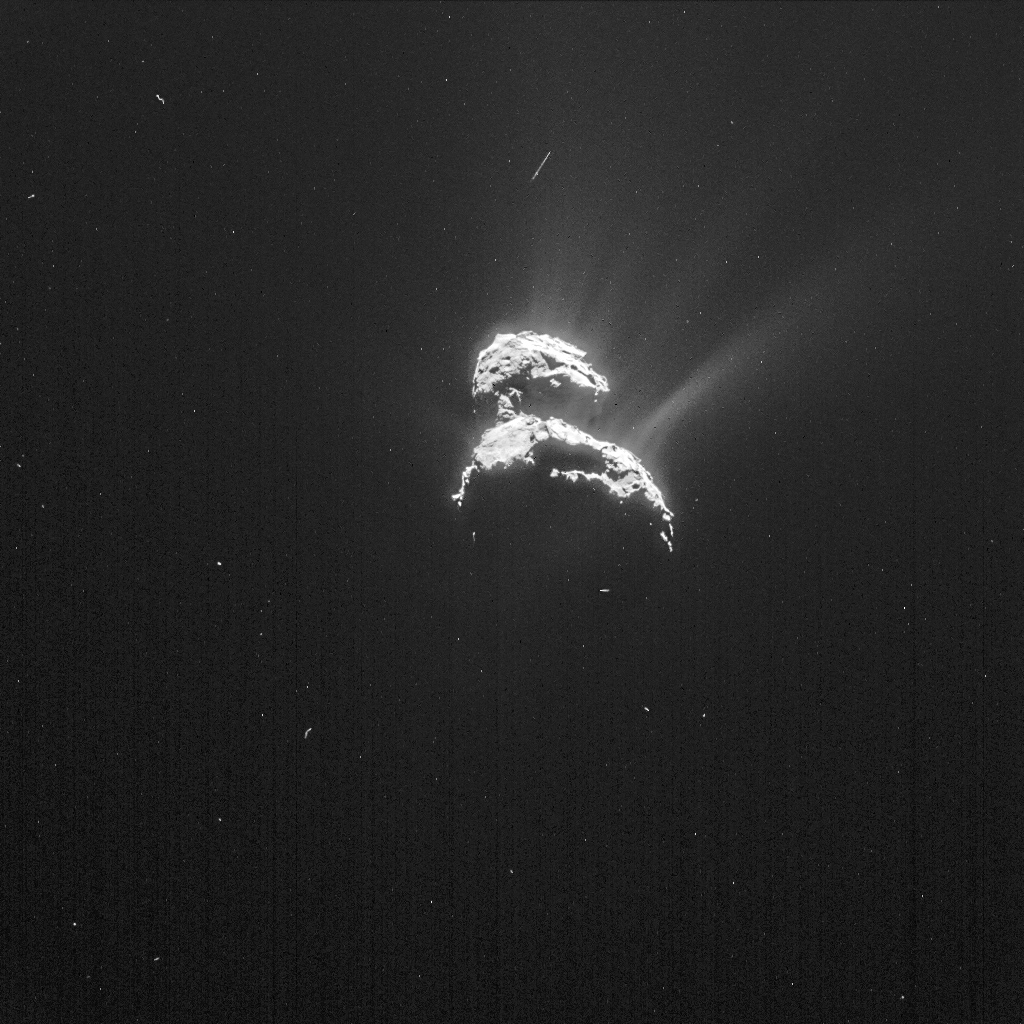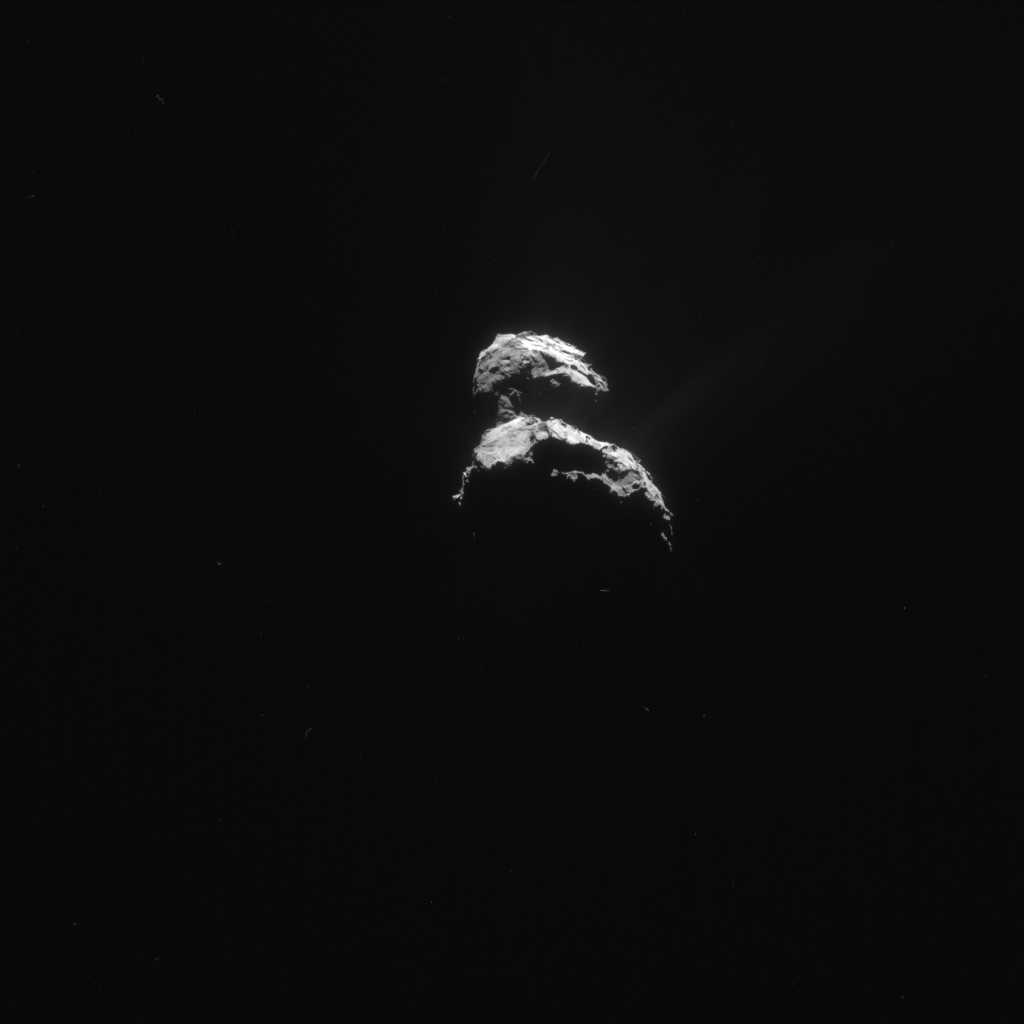Today’s CometWatch entry is a 1024 x 1024 pixel single frame NAVCAM image obtained on 18 February from a distance of 198 km from the centre of Comet 67P/Churyumov-Gerasimenko. The image has a resolution of 16.9 m/pixel and measures 17.3 km across.

NAVCAM image of Comet 67P/C-G taken on 18 February from a distance of 198 km to the comet centre. The image has been processed to bring out the details of the comet’s activity. The exposure time of the image is 4 seconds. Credits: ESA/Rosetta/NAVCAM – CC BY-SA IGO 3.0
While the original image (provided at the end of this post) is dominated by the nucleus, increasing the exposure emphasises the nebulosity of the coma and reveals the impressive nature of the comet’s jets streaming out into space (see image above). This also highlights the “noisy” background – typically a combination of detector noise, background stars, and grains of material ejected from the comet, which are sometimes captured as streaks.
Meanwhile on the comet’s large lobe, the dark shadowed region of Aten and the seemingly flat face of Khepry to its left stand out. On the small lobe, the regions known as Bastet and Ma’at are most clearly seen, while the cliffs of Hathor are largely in shadow. (Click here for a map of the comet’s regions.)
Today, 23 February, Rosetta flies by the comet at a distance of about 55 km. Click here for a video depicting the current trajectory of Rosetta.










Discussion: 9 comments
If this were the very only picture of the comet,
we might think that its nucleus consists of two parts,
rotating around each other.
Thanks for the photo,
Ingo.
PS. C-G should make a date with his barber 😉
So far we haven’t seen prominent jets from the head, so it that really a jet from the neck going past the head?
@ Kamal Lodaya
I think we can indeed safely assume that all the visible jets are once again fanning out from the neck region, as in every other image shown so far. The lobes are simply surrounded by a sort of luminous fuzz.
please don´t “clean” the photo, only leave compleatly, tks
The original image is also provided (the one at the end of the post).
To the navigation team and NavCam team:
it’s impossible to shot images at the apocomet positioning 67P in an angle of the field of view of the NavCams to show the extent and the shape of the jets far from the nucleus? If so we could analyze better their evolution.
Federico.
It has been observed by myself and THOMAS that an absence of ions in the comet jets would be needed to indicate that they are gas evolving under pressure from vents. In defence of the sublimation model Harvey has said that ions could be present in the jets as a result of photoionisation. In jets newly issuing at a speed of hundreds of metres/sec, from such a weak effect. Judge for yourselves. He also alleges that this photoionisation effect has already been noted by ESA. This is not the case. In a poster they published they comment on ion densities of 100 – 300 per cm cubed at an indeterminate position in the coma as being “consistent with photoionisation of cometary neutrals”. This is not of course a result but an interpretation of a result. Several other unacknowledged interpretations could account for that ion density.
I think we can safely assume that sublimated jets issuing under pressure would not be instantly photoionised and that the presence of ionised material would indicate their plasma nature and a different source.
The jet is illuminated with hard UV. What exactly would stop it being photoionised?
However the standard model would indeed indicate low density photoionisation.
We already know there is no highly ionised region there; if there were the optical signature from excited ions, atoms and molecules would be staring us in the face. They are commonly called ‘glow discharges’ for a reason; they glow.. We also know there are no magnetic fields consistent with massive local currents.
The discharge ‘model’ is falsified times over. The *only* support for it is a vague perceived similarity; that’s it.
Sure ‘sublimation’ has loads of explaining to do, but rests on rather more than that.
Harvey let us call any photoionisation effect that any neutral atoms in the heliosphere might be subject to the background ionisation level. This would be subtracted in any measurement of jet ionisation. If present it would be to a minute degree. We have previously discussed the fact that in the coma in general only about one millionth of the neutral material is likely to be photoionised. ESA have described this level as consistent with the effect. Measurement of the jets to establish or not their plasma discharge nature would be looking for a much higher degree of ionisation than that as well as identification of the ions..
I am not aware of any published specific measurement of the jets that would enable any property to be ruled out. The claim that they are illuminated only by reflected sunlight is an assumption. They could be intrinsically illuminated by photon emission, and be in glow mode. They would however still be classified as plasma discharge jets if they were in dark mode. It depends on the current and we do not know what that is. At a subsequent stage of higher current and higher activity the emission is likely to include x rays.
There has been no evidence to demonstrate that the comet activity is not a result of electrical discharge. No published plasma data, temperature data or magnetic data for the region from the nucleus surface out to a distance of a few kilometres. Until that data is available any supposition that they are not plasma is wishful thinking.